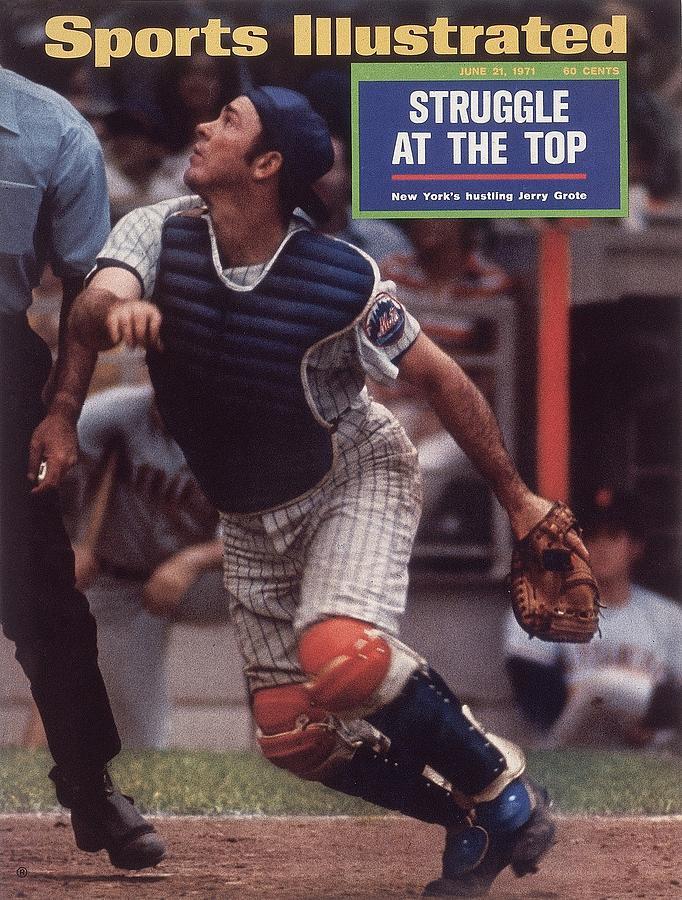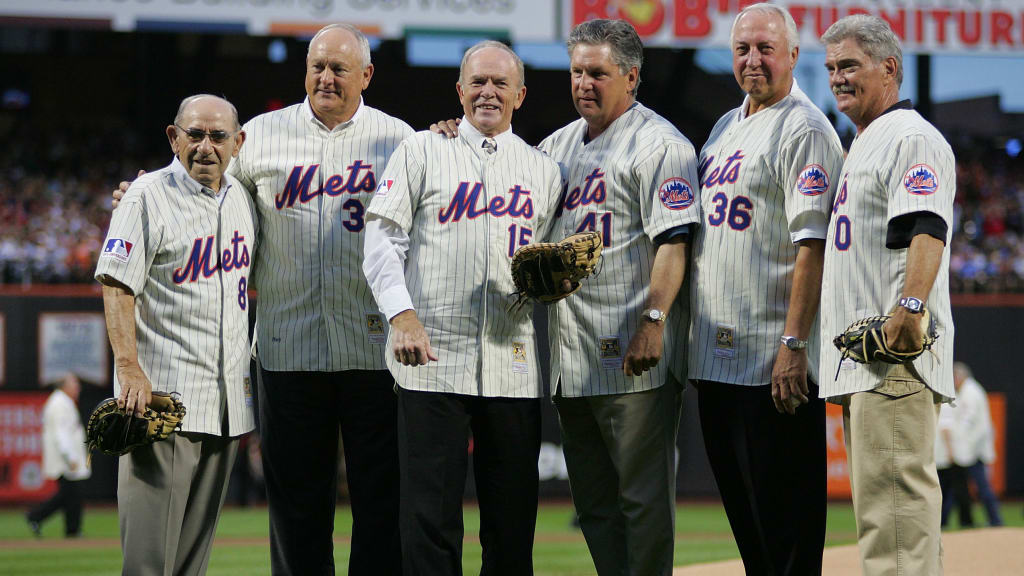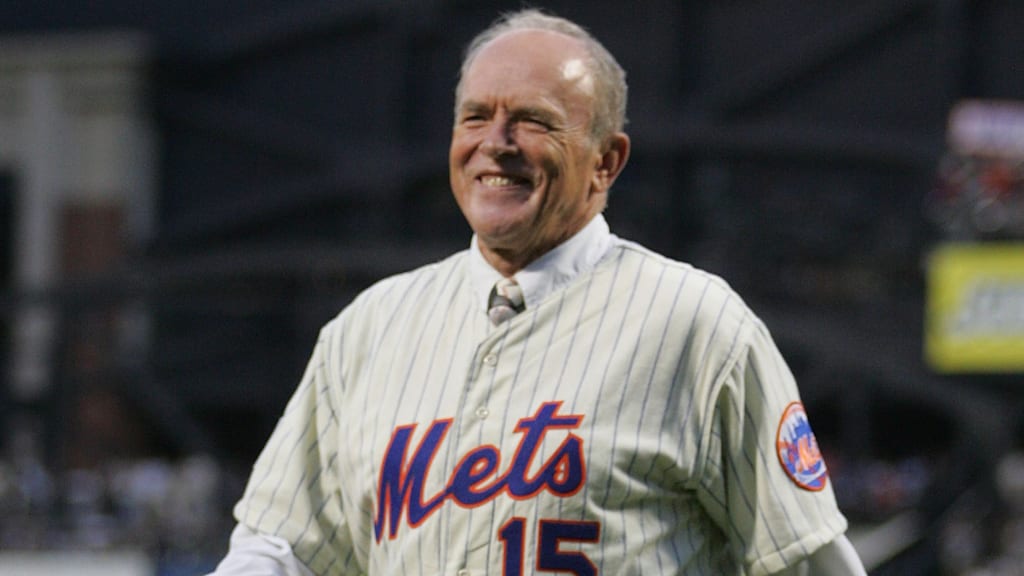Jerry Grote, the rifle-armed, tough-as-nails Texan who caught every postseason inning for the 1969 Miracle Mets and famously bear-hugged a leaping Jerry Koosman after the final out of the historic World Series upset of the Baltimore Orioles, and who was paid the ultimate catching compliments by none other than Hall of Famers Johnny Bench and Lou Brock, died on Sunday in Austin, Texas. He was 81.
Grote died at the Texas Cardiac Arrhythmia Institute in Austin, the Mets announced in a news release.
“We are incredibly saddened to hear about the passing of Jerry Grote," team owners Steve and Alex Cohen said in the release. "The Mets Hall of Famer was the backbone of a young Mets team who captured the heart of New York City in 1969. Known as the best defensive catcher in franchise history, he was a two-time All-Star who played 12 seasons in Flushing. We are grateful that Jerry was able to reunite with his teammates one last time during the 1969 World Series reunion at Citi Field in 2019. Our thoughts and prayers are with his wife, Cheryl, family and friends."
“He was the reason for my success," Koosman said in the release. "I have the photo in my home of me jumping into his arms after we won in 1969. I am heartbroken. No one was better behind the plate. He really controlled the game.”

Grote, the quintessential defense-first, light-hitting catcher of the 1960s and ’70s, played for four teams during a 16-year Major League career spanning 1963-81. But he will forever be identified for his time in New York from 1966-77, when he became a two-time All-Star (1968, ’74) and appeared on the cover of Sports Illustrated (’71). He guided the Tom Seaver-led pitching staff to one of the biggest upsets in baseball history in that 1969 World Series, then four years later again caught every postseason inning as the “Ya Gotta Believe” Mets took the vaunted Oakland A’s to the seventh game of the 1973 Fall Classic before succumbing.

The fullback-like 5-foot-10, 185-pound Grote with the surly personality totaled only 39 home runs with 404 RBIs and a .252 average during his career. He played with the Houston Colt 45s (1963-64), Mets, Dodgers (1977-78), Royals (1981) and again the Dodgers (1981). He played in two more World Series with Los Angeles in 1977 and ’78, losing both times to the Yankees. He played in 1,421 career games, 1,348 as a catcher. His career fielding percentage of .991 was eighth all-time at the time of his retirement.
Brock, who was the all-time stolen-base leader with 938 until being overtaken by Rickey Henderson in 1990, said in a 2012 SABR profile of Grote that he “was the toughest catcher in the league to steal on.”
"He’s the best catcher a pitcher would want to throw to," said Seaver, according to the Mets community website amazinavenue.com, which ranked Grote as the 30th-best player in Mets history.
Grote was behind the plate when Seaver pitched one of the most dominant games of his Hall of Fame career, agonizingly coming within two outs of a perfect game against the Cubs on July 9, 1969, at Shea Stadium.
In that same Amazin’ Avenue article, 1973 Mets starter Jon Matlack said of Grote: "He would come out to the mound, and you might have first and second and one out, and whoever you were facing, he’d relay to you exactly what had happened the previous at-bats, pitch by pitch by pitch, exactly where the guy hit the ball …"
Grote remains high on numerous Mets franchise statistical lists. He is fifth all-time in games played with 1,235, and is still first at catcher with 1,176. Grote also ranks in the franchise top-10 in at-bats and plate appearances, and top-20 in hits (994), RBIs and total bases. He was elected into the Mets Hall of Fame in 1992.

—---
Gerald Wayne Grote was born on Oct. 6, 1942, in San Antonio, Texas. He starred at Douglas MacArthur High School, where he threw a no-hitter as a pitcher, then stayed in his hometown to attend Trinity University for one year. Grote was signed as an amateur free agent in 1963 by the Colt 45s, now the Astros, and was assigned to their farm club in, you guessed it, San Antonio. He made his Major League debut at age 20 late in the 1963 season before being traded to the Mets after 1965.
Grote immediately became the Mets’ starting catcher on Opening Day 1966 and, no coincidence, that was the first season the franchise did not lose 100 games (66-95). In 1968, he hit .282 and was named the starting catcher for the National League All-Star team – an especially poignant recognition for Grote because the game was played in Texas at the Astrodome.
The catcher was fiery and tenacious and that made him great, but sometimes he went a bit far. He was known to be short-tempered with, well, just about everyone, including sportswriters, teammates and umpires. In a game in 1967 in which the Mets were already shorthanded a number of players, Grote was ejected for complaining about balls and strikes, forcing manager Wes Westrum to insert outfielder Tommy Reynolds into a game the Mets were leading the Dodgers but wound up losing. Westrum fined Grote $100 and the catcher was also reprimanded by general manager Bing Devine, as recounted in the SABR profile on Grote.
In the Amazin’ Avenue article, outfielder Ron Swoboda said Grote’s teammates could "barely stand him. He was a red-ass Texan who loved to [mess] with people but who didn't like anyone to [mess] with him. It was a one-way street. Grote is Grote."
Swoboda went on to say: "And we would not have been as good without him behind home plate."
That was never more evident than in 1969. Grote caught every inning in the three-game sweep of the Braves in the first NL Championship Series, then all five games of the victorious World Series. With Grote guiding the Mets’ elite pitching staff – led by Seaver and Koosman and including a 22-year-old hard-throwing Texan named Nolan Ryan – the Orioles scored only nine total runs in the Series and hit a collective .146. Grote even contributed hits during two of the four winning rallies. When the 66th Fall Classic ended with Cleon Jones catching Davey Johnson’s fly ball to left field, Koosman famously leaped into the arms of Grote at the mound as the Miracle Mets’ celebration began.

In 1973, Grote and the Mets were back in the World Series after disposing of Pete Rose, Joe Morgan, Bench and the Big Red Machine in the five-game NLCS. They wound up losing to the A’s in a seven-game Fall Classic. Grote contributed eight hits in the Series.
He was an All-Star again in 1974. Age and injuries started to mount in 1977 and, with a young John Stearns now the No. 1 catcher, Grote was traded to the Dodgers. It was with Los Angeles that he had his one career at-bat against Seaver, who by then had been traded to the Reds, and he struck out. Grote retired after two World Series-losing seasons with the Dodgers – despite being offered a job by the Yankees to be Thurman Munson’s backup in 1979.
But Grote was not completely done. Three years later, he was lured back by the catcher-needy Royals. On June 3, 1981, Grote went 3-for-4 with a grand slam, double and stolen base, driving in a then-team-record seven runs in a 12-9 win over the Mariners. It was his final hurrah and two months later, he was released. Grote was picked up by the Dodgers in September, played in just two games for L.A., and that was that on a gritty 16-year career.
Grote went on to business ventures in San Antonio. He was inducted into the Texas Baseball Hall of Fame in 1991 and the San Antonio Sports Hall of Fame in 1998, according to SABR. He is survived by his current wife, Cheryl, his three children and six grandchildren.
Grote will never make it to the Baseball Hall of Fame in Cooperstown, but his place in the game is secure. In his playing days, he was one of the best defensive catchers around, if not the best. If that sounds like hyperbole, that’s not us talking. It’s perhaps the man considered the best catcher and best defensive catcher in baseball history talking: Johnny Bench.
“If Grote and I were on the same team,” the eight-time NL Gold Glove winner once said, "I would be playing third base.”
